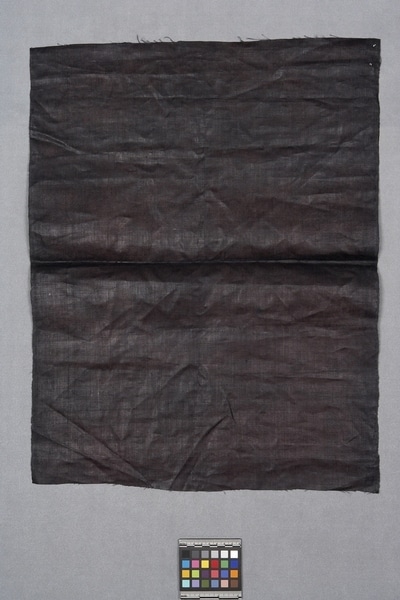Cloth Item Number: Edz1058 from the MOA: University of British Columbia

Description
Black glazed hemp cloth. The rectangular cloth has selvage sides and cut ends.
History Of Use
In the Tsuen Wan villages until about the 1950s, women often wore clothing made of hemp, especially in summer. It was heavily dyed so that the dye at first came off on their hands when the clothing was new. They prepared the hemp themselves and spun it, and it was then often woven by itinerant weavers and cut and sewn by local tailors. A very old song sung by Mrs. Yau Chan, Shek-ying suggests that they sometimes wove it themselves. Cloth of this type was made into the side-fastening tunics worn with pants by women. The styles changed over time, with the tunics becoming somewhat shorter and less voluminous. By the 1960s-70s, younger women were wearing fitted side- or front-fastening tops, sometimes with short sleeves. The pants were sometimes made of the same fabric, or plain fabric. The set of matching top and pants was called saamfuh. Men also wore clothing made of dyed or glazed hemp as well as other fabrics. They changed to westernized clothing earlier than women did, however, and by the late 1960s it was only elderly men who wore Chinese style clothes. After the mid-twentieth century the New Territories of Hong Kong began to undergo fundamental changes. The people who had been settled there before 1898, when the British colonizers claimed the area, began to give up rice agriculture and coastal fishing, turning instead to wage labour and increased employment overseas. By the end of the century, educational opportunities leading to the possibility of white-collar work also increased, together with western influences. These changes meant that objects and clothing once useful and appropriate were no longer needed and generally were discarded. Some were saved by their owners, who sometimes were willing to donate them to museums, sharing, also, their knowledge of how they were made and used.
Narrative
As Hong Kong’s New Territories modernized it was common for people to give up objects that were no longer useful. Mr. Chan, Heng-faat kindly donated this piece of heirloom fabric that had belonged to his mother.
Item History
- Made in Tsuen Wan, Hong Kong, China during 1920
- Collected by Elizabeth L. Johnson during 1979
- Owned by Heng-faat Chan
- Owned by Elizabeth L. Johnson before March 17, 1980
- Received from Elizabeth L. Johnson (Seller) and Museum of Anthropology Shop Volunteers (Funding source) on March 17, 1980
What
Who
- Culture
- Chinese: Hakka
- Field Collector
- Elizabeth L. Johnson
- Previous Owner
- Heng-faat Chan and Elizabeth L. Johnson
- Received from
- Elizabeth L. Johnson (Seller) and Museum of Anthropology Shop Volunteers (Funding source)
Where
- Holding Institution
- MOA: University of British Columbia
- Made in
- Tsuen Wan, Hong Kong, China
When
- Creation Date
- during 1920
- Collection Date
- during 1979
- Ownership Date
- before March 17, 1980
- Acquisition Date
- on March 17, 1980
Other
- Item Classes
- textiles
- Condition
- good
- Accession Number
- 0610/0028